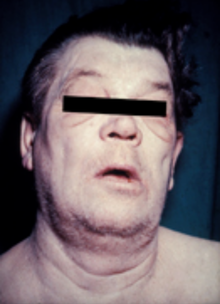User:Mr. Ibrahem/Myxedema coma
| Myxedema coma | |
|---|---|
 | |
| Face of someone with myxedema showing an expressionlessness, periorbital puffiness, and pallor | |
| Specialty | Endocrinology |
| Symptoms | Altered mental status, low body temperature[1] |
| Complications | Respiratory failure[2] |
| Usual onset | Older females[1] |
| Risk factors | Untreated hypothyroidism[1] |
| Diagnostic method | Based on symptoms together with lab tests[2] |
| Differential diagnosis | Sepsis, seizure, diabetic ketoacidosis, overdose[2] |
| Treatment | Levothyroxine (T4), hydrocortisone, antibiotics[1] |
| Frequency | Rare[2] |
| Deaths | 20 to 50% of cases[1] |
Myxedema coma is a decompensated form of hypothyroidism.[1] Typical symptoms include altered mental status and low body temperature.[1] Other symptoms may include sleep apnea, puffy skin, hair loss, and abdominal bloating.[2] Coma; however, is not typically present.[1] Complications may include respiratory failure.[2]
It generally occurs in those with hypothyroidism that is severe and untreated.[1] Often an event such as dehydration, infection, or stroke triggers its development.[1][2] Laboratory tests typical show a low thyroid state (low free T4 and high TSH).[1] Other finding may include low blood pressure, slow heart rate, slow reflexes, low sodium, and low blood sugar.[1]
Early treatment with thyroid hormone is key.[1] This is generally given as a 300 to 500 ug intravenous dose of levothyroxine (T4), though some also use liothyronine (T3).[1] Hydrocortisone 100 mg and antibiotics are also often given.[1] While warming a person by giving heating intravenous fluids is reasonable, there are concerns that just warming a persons skin could further lower their blood pressure.[1] Risk of death is about 20 to 50%.[1]
Myxedema coma is rare affected about 1 in 5 million people per year.[2] Those affected are usually older and female.[1] Onset is often in the winter.[1] The condition was initially described by Ord in 1879.[3]
References[edit]
- ^ a b c d e f g h i j k l m n o p q r s Wiersinga, WM; Feingold, KR; Anawalt, B; Boyce, A; Chrousos, G; de Herder, WW; Dhatariya, K; Dungan, K; Hershman, JM; Hofland, J; Kalra, S; Kaltsas, G; Koch, C; Kopp, P; Korbonits, M; Kovacs, CS; Kuohung, W; Laferrère, B; Levy, M; McGee, EA; McLachlan, R; Morley, JE; New, M; Purnell, J; Sahay, R; Singer, F; Sperling, MA; Stratakis, CA; Trence, DL; Wilson, DP (2000). "Myxedema and Coma (Severe Hypothyroidism)". PMID 25905238.
{{cite journal}}: Cite journal requires|journal=(help) - ^ a b c d e f g h Elshimy, G; Chippa, V; Correa, R (January 2022). "Myxedema". PMID 31424777. Archived from the original on 7 September 2021. Retrieved 29 March 2022.
{{cite journal}}: Cite journal requires|journal=(help) - ^ Eaton, Jennifer L. (31 October 2018). Thyroid Disease and Reproduction: A Clinical Guide to Diagnosis and Management. Springer. p. 33. ISBN 978-3-319-99079-8. Archived from the original on 30 March 2022. Retrieved 29 March 2022.
